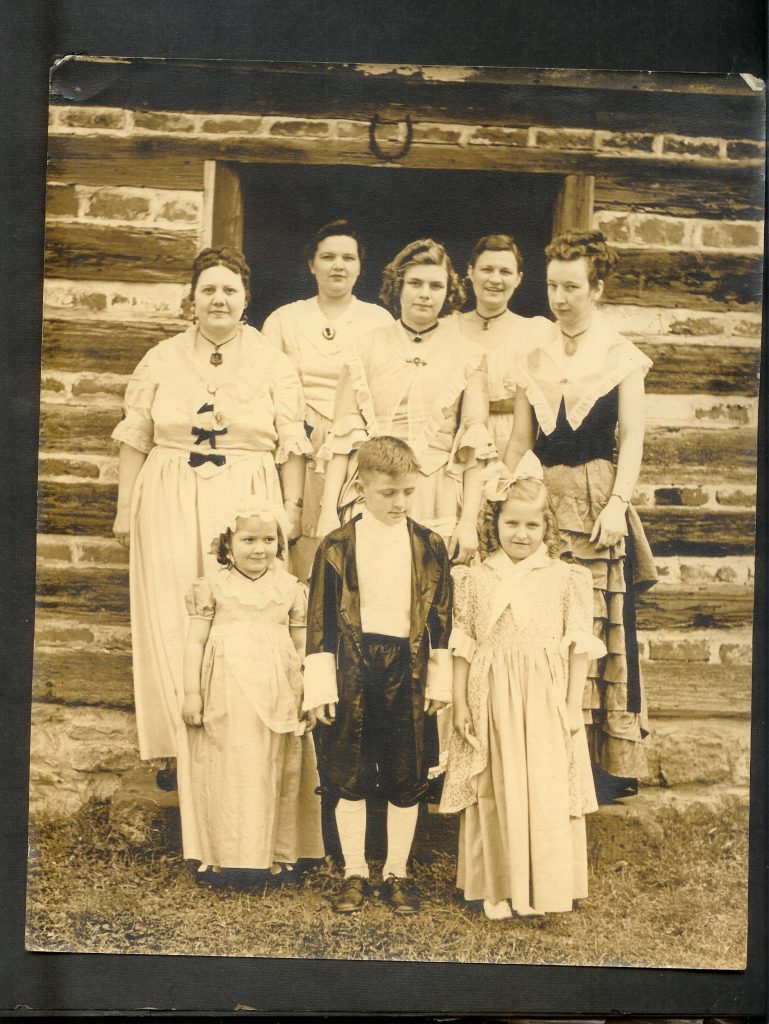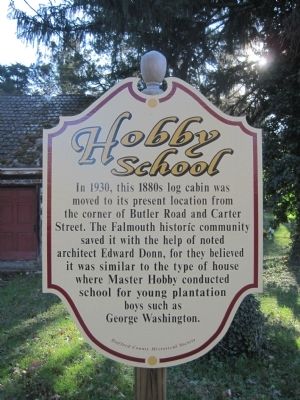Hobby School
The small log building in Falmouth that we know as Hobby School is one such place where little documented history exists, but a wealth of oral tradition abounds. For decades, locals have claimed that, as a lad, George Washington attended school in this building and was taught by John Hobby. In truth, Mr. Hobby served as sexton at the Brunswick Parish church that originally stood behind the present Union Church. It is quite plausible that he also taught school.
One long-forgotten but important detail about this little building is its original location; it has only been on the present site since 1930. Wherever it stood, at some point, the structure was dismantled and the logs were safely stored in Dr. Elliott B. Jett’s barn in Falmouth. During the late nineteenth and early twentieth centuries, log structures were common in Stafford and it’s unlikely that anyone would have taken up space in his barn to store a disassembled one. Given the number of logs and the amount of space this would have required in the barn, it seems reasonable to assume that someone had a very good reason for preserving it.
In 1929, Dr. Jett’s heirs sold a parcel of his real estate to the Citizen’s Guild of Washington’s Boyhood Home, Inc. This group was one of the early contributors to the Wakefield project. The Guild paid $2,000 for a strip of property that was bounded by Carter Street, Butler Road, and the Falmouth Cemetery. Included in this was the present site of Hobby School. The deed specified that the Guild had the right to tear down the four buildings then standing on the property. One of these was Dr. Jett’s barn that stood on the corner of Carter Street and Butler Road. A brick thrift shop now occupies this space. One wonders why a group involved with Washington’s boyhood home would want the Jett property unless it was to obtain the logs stored in his barn. It may not be a coincidence that the little log building was reassembled the following year.
The acquisition of the purported school coincided with the fundraising efforts to rebuild the Washington home at Wakefield and with the Colonial Revival Movement that influenced architecture, interior design, and landscaping for the next fifty years. Work on the little building was overseen by the noted Colonial Revival architect, Edward Donn.
Originally, the spaces between the logs would likely have been chinked with wood scores and clay. Falmouth mason, St. Clair Brooks, worked on the building and added the bricks between the logs. He also built the stone chimney on the end. The squatty stone piers or posts placed along the front and north side were moved from a little park that had occupied a lot across U S. Route 1 from the Cotton Warehouse, now Simpson’s Realty. The park area was later utilized by the Noble car dealership and is now the vacant area on the southeast side of the reconfigured Falmouth intersection. The large freestone (sandstone) step with curved corners that now rests at Hobby School’s only door may have been moved from the front of Union Church. The two sets of steps in front of the façade are now of poured concrete, but were originally of freestone.
The Citizen’s Guild held the property until 1938 when they sold a 45-foot by 145-foot parcel, including the log school, to the Civic Improvement Club of Falmouth. This group paid $300 for the property. In November 1984, the Club conveyed it in a deed of gift to Historic Falmouth Towne and Stafford County, Incorporated (which in 1991 became the Stafford County Historical Society).
For the 1985 dedication of Hobby School, two HFT & SCI members built a few student desks from wood salvaged after the collapse of Union Church.
While it’s impossible at this time to prove that George Washington attended school in this building, it’s also impossible to disprove it. Architecturally, many early school buildings would have been of log construction. The ends of the Hobby School logs are notched in an early style unlike those in later log buildings. Having a dendrochronology done on the logs would help determine the year they were cut, but this is expensive and has not been done.



